![]() Before we take a closer look at the Gimlet and Rose’s Lime Juice, which for some is a mandatory ingredient for this drink, it is necessary for a deeper understanding of these two to first take a detailed look at the history of preserved lime juice. When did people start using it? How was it made? What were the problems?
Before we take a closer look at the Gimlet and Rose’s Lime Juice, which for some is a mandatory ingredient for this drink, it is necessary for a deeper understanding of these two to first take a detailed look at the history of preserved lime juice. When did people start using it? How was it made? What were the problems?
Lime Juice
Citrus juice was used early on as an ingredient for mixed drinks. Everything practically began with the Punch. The reader can read about the history of punch in our series of posts. At this point, the essentials concerning citrus fruits should be repeated. As early as the end of the 16th century, the effectiveness of citrus fruits in curing scurvy was reported. [39-36] A medical work of the East India Company published in 1617 recommends the daily administration of citrus juice if supplies permit. [40-184] [40-185]
Lime juice export
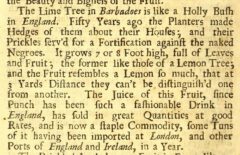
In a 1708 book on the history of Barbados, John Oldmixon writes about lime juice: [3-92] [7-838] “The Juice of this Fruit, since Punch has been such a fashionable Drink in England, has sold in great Quantities at good Rates, and is now a staple Commodity, some Tuns of it having been imported at London, and other Ports of England and Ireland, in a Year.” [3-92]
Likewise, he reports: [3-155] [7-900] “They also ship Lignum Vitae, Succats, Citron-Water, Melasses, Rum, and Lime-juice, for England. The two last Commodities, about 20 Years ago, us’d to come in Kegs for Presents, so did the Succats; and the Citron-Water in Bottles: But now French Wine and Brandy are dear, and Lemons scarce, Rum-Punch has been much us’d, and Lime-juice supply’d the place of Lemons.” [3-155]
In 1714, customs records document that lime juice was shipped in 32-gallon barrels. [4-57] [4-58]
But the juice was not only bottled in barrels. An exchange of letters with Fort St. George in Madras, built by the British in 1640, [2] shows that lime juice was bottled as early as 1704: “We have now sent you a bulloon with Casks of water 2 Bottles of Lime Juice and a cask of Arrack“. [1-108]
Israel Acrelius also reports in his 1759 [61] account of New Sweden that bottled and imported lime juice was used to make punch: “Punch is made of fresh spring-water, sugar, lemon-juice, and Jamaica spirits. Instead of lemons, a West India fruit called limes, or its juice, which is imported in flasks, is used.” [60-162]
What is “Citron-Water” and “Lime-Juice”?

Citron water and lime juice were exported from Barbados early on. What should we understand by this? A book from the year 1725 provides information by publishing recipes for both. It says that lemon water is made from brandy, dried lemon peel and sugar: “Lemon or Orange-water. 20 gallons of rectify’d Spirits … 6 pounds of Lemon or Orange-peels dry’d … 7 pounds of Sugar … Directions for Orange-water, &c. Lemon-water is not near so much in request as Orange-water, nor indeed is it so pleasant or grateful to the palate as Orange: they are not much known, or used in the country: but the agreeable relish, or flavour thereof, will make it much preferable to the double or single Anniseed. Clove, Angelica, or such like goods: I mean Orange, especially double Orange, which is sold much dearer than other such like goods; purely to get an opinion in the buyer, that it is a more rich and valuable Commodity: and the more to keep up its reputation, as well as the temptation of a greater profit thereby. The skins or peels muft be all of the Sevil, and none of the China Oranges; and muft be kept very dry, or they will grow damp and putrefy’d, and not fit to be used. If you buy or procure green Orange-peel, you muft spread it very thin in a dry chamber, and turn it oft, and not put it by for use, ’till exceedingly well dry’d.” [5-28] [5-29]
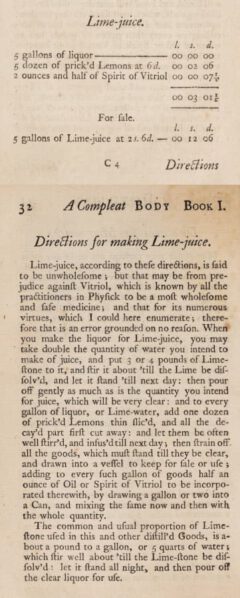
The same book also tells us about Lime-Juice: “Lime-juice. 5 gallons of liquor … 5 dozen of prick’d Lemons … 2 ounces of Spirit of Vitriol … Directions for making Lime-juice. Lime-juice, according to these directions, is said to be unwholesome; but that may be from prejudice against Vitriol, which is known by all the practitioners in Physick to be a most wholesome and safe medicine; and that for its numerous virtues, which I could here enumerate; therefore that is an error grounded on no reason. When you make the liquor for Lime-juice, you may take double the quantity of water you intend to make of juice, and put 3 or 4 pounds of Lime-stone to it, and stir it about ’till the Lime be dissolv’d, and let it stand ’till next day; then pour off gently as much as is the quantity you intend for juice, which will be very clear: and to every gallon of liquor, or Lime-water, add one dozen of prick’d Lemons thin slic’d, and all the decay’d part first cut away: and let them be often well stirr’d, and infus’d till next day; then strain off all the goods, which must stand till they be clear, and drawn into a vessel to keep for sale or use; adding to every such gallon of goods half an ounce of Oil or Spirit of Vitriol to be incorporated therewith, by drawing a gallon or two into a Can, and mixing the same now and then with the whole quantity. The common and usual proportion of Lime-stone used in this and other distill’d Goods, is about a pound to a gallon, or 5 quarts of water; which stir well about ’till the Lime-stone be dissolv’d; let it stand all night, and then pour off the clear liquor for use.” [5-31] [5-32]
We have to dwell a little on this quotation. First of all, about 405 grams of limestone are dissolved in four and a half litres of water, then twelve finely chopped lemons are infused in the drained liquid in 4.5 litres each. The liquid is then poured off and “oil or spirit of vitriol” is added to preserve it, i.e. sulphuric acid or iron(II) sulphate, also called green vitriol. [41] [42] [43] [44] [45]
The preservation of fruit with limestone is reminiscent of the preservation of water with limestone. Experiments were also made with lime-water to preserve other foods with it.
Lime-Water
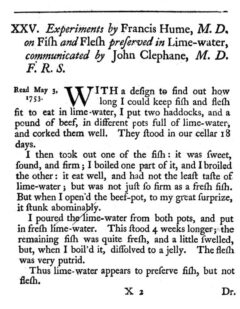
In 1753, a report appeared in this regard on “Experiments by Francis Hume, M.D. on Fish and Flesh preserved in Lime-water, communicated by John Clepane, M. D. F. R. S. With a design to find out how long I could keep fish and flesh fit to eat in lime-water, I put two haddocks, and a pound of beef, in different pots full of lime-water, and corked them well. They stood in our cellar 18 days. I then took out the fish: it was sweet, sound, and firm; I boiled one part of it, and I broiled the other: it eat well, and hat not the least taste of lime-water; but was not just so firm as a fresh fish. But when I open’d the beef-pot, to my great surprize, it stunk abominably. I poured the lime-water from both pots, and put in fresh lime-water. This stood 4 weeks longer; the remaining fish was quite fresh, and a little swelled, but, when I boil’d it, dissolved to a jelly. The flesh was very putrid. Thus lime-water appears to preserve fish, but not flesh.“ [47-163]
1754 erscheint „Ein Bericht über einige Versuche, Wasser und Fische süß zu halten, mit Kalkwasser. Von Stephen Hales, D. D. F. R. S. Dr. Alston aus Edinburgh hat herausgefunden, daß der kleine Anteil von einem Pfund Calciumhydroxid in einem Hogshead mit Wasser verrührt, das Wasser wirksam süß erhielt, nicht nur in einem Glas oder in irdenen Gefäßen, sondern auch in einem neuen Eichengefäß.“ [48-826] Der Autor berichtet über seine Versuche zu diesem Thema. Eine seiner Beobachtungen zur Haltbarkeit von Wasser war: „Mit Kreide-Kalk [chalk-lime], im Verhältnis von zwei Pfund zu einem Hogshead, stank es bald sehr, und das tat es vier Monate lang. Es handelte sich um Themse-Wasser, das unterhalb der London Bridge entnommen wurde und das bekanntlich wieder süß wird, nachdem es einige Zeit gestunken hat. Kreide-Kalk (fast die einzige hier gebräuchliche Sorte) bewahrt das Wasser also nicht vor Fäulnis, obwohl Steinkalk [stone-lime], wie Dr. Alston glücklicherweise herausgefunden hat, das Wasser in hohem Maße vor dem hohen Grad der Fäulnis bewahrt, dem es unterworfen ist, und daher auf See sehr brauchbar sein könnte. Von einem, der in Ost-Indien war, wurde mir mitgeteilt, daß man dort herausgefunden hat, daß einheimischer mineralischer Schwefel das Wasser in Erdkrügen süß erhält, an Land und auch auf See (aber ich weiß nicht, ob in Krügen, wahrscheinlich in Fässern)“. [48-827] [48-828] Seine Versuche zeigen: „Daher könnte einheimischer mineralischer Schwefel von Nutzen sein, um das Wasser vor großen Fäulnisgraden auf See zu bewahren.“ [48-828] Er fährt fort: „Nachdem Dr. Alston mir geschrieben hatte, daß er herausgefunden habe, daß Fische in Kalkwasser für sieben und mehr Wochen süß bleiben würden, legte ich am 19. April vier Gründlinge in Kalkwasser aus weißem Marmor. Am 10. Mai waren sie süß; aber als ich einen von ihnen kochte, wurde das Fleisch, obwohl süß, zu einem weichen Brei.“ [48-828]

In 1754, “An Account of some Trials to keep Water and Fish sweet, with Lime-water. By Stephen Hales, D. D. F. R. S. Dr. Alston, of Edinburgh, having found, that the small proportion of a pound of slack’d lime in a hogshead of water, stirring it, effectually preserved the water sweet, not only in a glass or earthen vessels, but also in a new oaken vessel.” [48-826] was published. The author reports on his experiments on this topic. One of his observations on the durability of water was: “With chalk-lime, in the proportion of two pounds to a hogshead, it soon stunk much, and continued so to do for four months. This was Thames-water, taken up below London-bridge, which is well known to grow sweet again, after having stunk for some time. So that chalk-lime (almost the only sort in use here), will not preserve water from putrefaction: though stone-lime, as Dr. Alston has happily discovered, does preserve water in a great measure from the great degrees of putrefaction it is subject to, and therefore may be very servicable at sea. Being informed, by one, who had been in the East-Indies, that native mineral sulphur had been found to keep water sweet there in earthen-jars, at land, and also at sea, (but I know not whether in jars, probably in casks)”. [48-827] [48-828] His experiments show: “Hence native mineral sulphur may be of service to preserve water from great degrees of putrefaction at sea.” [48-828] He continues: “Dr. Alston having written me word, that he found fish would continue sweet in lime-water for seven and more weeks, April 19, I put four gudgeons into white marble lime-water. May 10, They were sweet; but on boiling one of them, the flesh, though sweet, was reduced to be soft pap.” [48-828]
Finally, in 1781, Henry Thomas published “An account of a method of preserving water, at sea from putrefaction, and of restoring to the water its original pleasantness and purity, by a cheap and easy process; to which is added a mode of impregnating water, in large quantities, with fixed air, for meicinal uses, on board ships, and hospitals; and likewise a process for the preparation of artificial yeast.” [49]

He saw adding carbonic acid to water as a way to keep it from spoiling, because “The drinking of putrid water is not only highly disagreeable and disusting, but extremely noxious to the constitution.“ [49-5]
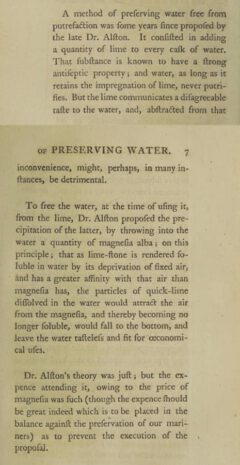
He states: “A method of preserving water free from putrefaction was some years since proposed by the late Dr. Alston. It consisted in adding a quantity of lime to every cask of water. That substance is known to have a strong antiseptic property; and water, as long as it retains the impregnation of lime, never putrifies. But the lime communicates a disagreeable taste to the water, and, abstracted from that inconvenience, might, perhaps, in many instances, be detrimental. To free the water, at the time of using it, from the lime, Dr. Alston proposed the precipitation of the latter, by throwing into the water a quantity of magnesia alba; … Dr. Alston’s theory was just; but the expence attending it, owing to the price of magnesia was such (though the expence should be great indeed which is to be placed in the balance against the preservation of our mariners) as to prevent the execution of the proposal.” [49-6] [49-7]

Henry Thomas then describes how he did experiments: “In order to produce this effect, I have made a variety of experiments, with the relation of which I shall not detain the reader; but shall proceed to describe the method of impregnating the water with lime, and also the means of precipitating the lime from the water, at the time of its use, and restoring its original sweetness and pleasantness; after which I shall give an account of an easy method of impregnating water, in large quantities, with fixed air, for the use of the sick on board his Majesty’s and other ships, as well as for hospital practice.” [49-9] [49-10]
Then follows the chapter on “The Method of impregnating the Water with Quick-Lime“, [49-10] followed by “The Method of freeing the Water from Lime, and restoring it to its former State“. [49-11] His proposal was to let sulphuric acid react with calcium carbonate, and to pass the carbon dioxide produced, which reacts in the water to form carbonic acid, through the lime water so that the contained lime precipitates as carbonate. [50] [51]
But back to the recipe for Lime-Juice. According to the explanations given, it is clear that the lemons were preserved with lime(stone) water and sulphuric acid or iron(II) sulphate. Based on this, we also have the question of whether a correct translation of lime-juice would be lime(stone) juice or lime(fruit) juice, at least as far as this old recipe is concerned. For lime in English is not only limestone, calcium oxide or lime (tree), but also lime (fruit: lime or lemon). However, as we shall see, limes (the fruits) are certainly used in more recent recipes to make lime-juice and the name thus acquires a double meaning. Further etymological research might be interesting here.
What kind of limestone was used is not entirely clear, because limestone is not only understood to mean strongly consolidated limestones, but also relatively friable rocks such as chalk. Finally, Thomas Henry even speaks of burnt lime, which is highly caustic. [46] [52] [53]

A book published in 1736 describes almost word for word the recipe we have already described from 1725. [6-183] [6-184]
More recent recipes for making Lime Juice
Let us now look chronologically at the more recent recipes for making Lime Juice to see if and how they have changed over time to better solve the problem of preservation. We deliberately leave out the texts on Rose’s Lime Juice for the time being. We do not want to deal with this until we have a sufficient overview of the various preservation methods and the problems associated with them. To do this, it is unfortunately necessary to look at a relatively large number of sources, because only in this way can one get an impression of how difficult it must have been to find a viable method of preserving the juice, full of trials, errors and confusions.
In this context, we must briefly mention the shrub. The term ‘shrub’ is derived from the Arabic word ‘sharaba’, which means ‘to drink’. [57] It was understood in England to mean “A prepared drink made with the juice of orange or lemon (or other acid fruit), sugar, and rum (or other spirit).” [56-787]

According to the Oxford English Dictionary, the word was first mentioned in 1747: [56-787] in an article entitled »A Method for preserving the Health of the SEAMEN in long Cruizes and Voyages«, written in Plymouth in September 1747, lime juice is also mentioned: “In autumnal Cruizes a Quantity of Apples might be also carried, which, when well chosen, and well put up in dry tight Casks, will keep very good for two or three Months. Even Lemons and Oranges wrap’d in Flannel (or something that will imbibe their exhaling Moisture) kept in close dry Vessels, and pretty cool, may be preserved a long while also; they are sometimes vastly cheap, and would make a very useful Part of the Stores. If this is not so feasible, a Mixture of Lemon Juice and Rum (Shrub, as they call it) may be carried in any Quantity, as it will keep a long Time, and would prove infinitely more wholesome than the nasty fiery poisonous Spirits, which are dealt about so largely in the Navy and elsewhere. By the bye, nothing would more effectually correct the pernicious Qualities of these Spirits than Lemon Juice. In the Case of stinking Water, Juice of Lemon, Elixir of Vitriol, or Vinegar, should be always mix’d with it; which will render it much less unwholesome. The Roman Soldiers drank Posca (viz. Water and Vinegar) for their common Drink, and found it very healthy and useful.” [55-269] [55-270]
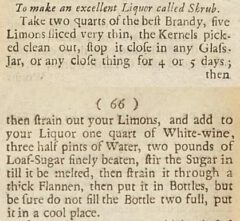
However, the dictionary is wrong. The term shrub can be traced back to an earlier English book: In 1705, ‘The Pastry-Cook’s Vade-Mecum’ states: “To make an excellent Liquor called Shrub. Take two quarts of the best Brandy, five Limons sliced very thin, the Kernels picked clean out, stop it close in any Glass-Jar, or any close thing for 4 or 5 days; then strain out your Limons, and add to your Liquor one quart of White-wine, three half pints of Water, two pounds of Loaf-Sugar finely beaten, stir the Sugar in till it be melted, then strain it through a thick Flannen, then put it in Bottles, but be sure do not fill the Bottle two full, put it in a cool place.” [58-65] [58-66]
In 1743 Elizabeth Moxon, in her book ‘English Housewifery’, reports preserving orange juice by adding sugar and brandy. [57] We see from these two examples that the range of shrubbing is wide. It is not always a mixture of citrus juice, sugar and spirits.
An important milestone is the year 1795, when the use of lime juice became compulsory in the British navy. [10-698]
At the beginning of the 19th century, the US Navy also thought about how to preserve lime juice. This was achieved by boiling the juice in an earthen vessel and removing the sediment with a wooden ladle. When a quarter of the juice had evaporated, it was taken off the heat and strained through a flannel cloth. Half a pint of brandy was added per gallon and the mixture sealed in bottles. [54] [27-70] [27-71]
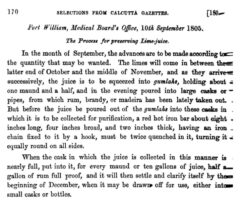
In 1805, the Calcutta Gazette writes: “Fort William, Medical Board’s Office, 10th September 1805. The Process for preserving Lime-juice. In the month of September, the advances are to be made according to the quantify that may be wanted. The limes will come in between the latter end of October and the middle of November, and as they arrive successively, the juice is to be squeezed into gumlahs, holding about one maund and a half, and in the evening poured into large casks or pipes, from which rum, brandy, or madeira has been lately token out. But before the juice be poured out of the gumlahs into these casks in which it is to be collected for purification, a red hot iron bar about eight inches long, four inches broad, and two inches thick, having an iron chain fixed to it by a hook, must be twice quenched in it, taming it equally round on all sides. When the cask in which the juice is collected in this manner is nearly full, put into it, for every maund or ten gallons of juice, half a gallon of rum full proof, and it will then settle and clarify itself by the beginning of December, when it may be drawn off for use, either into small casks or bottles.” [14-170]
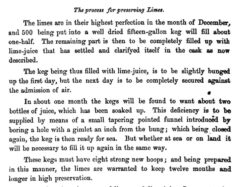
Subsequently, it is also indicated how to preserve limes, completely without using lime(stone) water: “The process for preserving Limes. The limes are in their highest perfection in the month of December, and 500 being put into a well dried fifteen-gallon keg will fill about one-half. The remaining part is then to be completely filled up with lime-juice that has settled and clarifyed itself in the cask as now described. The keg being thus filled with lime-juice, is to be slightly bunged up the first day, but the next day is to be completely secured against the admission of air. In about one month the kegs will be found to want about two bottles of juice, which has been soaked up. This deficiency is to be supplied by means of a small tapering pointed funnel introduced by boring a hole with a gimlet an inch from the bung; which being closed again, the keg is then ready for sea. But whether at sea or on land it will bo necessary to fill it up again in the same way. These kegs must have eight strong new hoops; and being prepared in this manner, the limes are warranted to keep twelve months and longer in high preservation.” [14-170]
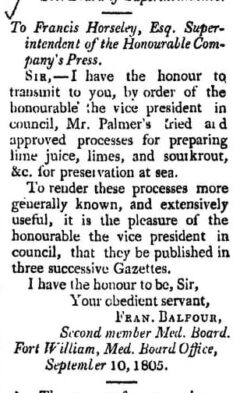
In 1807, this description is republished in the Philadelphia Medical Museum, where it is called “Palmer’s process”. [11-cxxvi] [11-cxxvii] The Asiatic Annual Register also prints this description in 1805 with the introductory recommendation: “To Francis Horseley, Esq, Superintendent of the Honourable Companys Press, Sir, — I have the honour to transmit to you, by order of the honourable the vice president in council, Mr. Palmer’s tried and approved processes for preparing lime juice, limes, and sourkrout, &c. for preservation at sea. To render these processes more generally known, and extensively useful, it is the pleasure of the honourable the vice president in council, that they be published in three successive Gazettes. I have the honour to be, Sir, Your obedient servant, Fran. Balfour, Second member Med. Board, Fort Wiliam, Med. Board Office, September 10, 1805.” [12-61] [12-62]
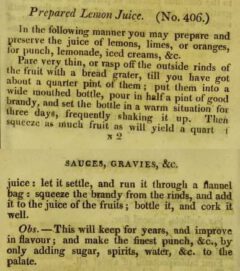
In 1825, a cookbook describes how to make lime juice: “Prepared Lemon Juice. (No. 406.) In the following manner you may prepare and preserve the juice of lemons, limes, or oranges, for punch, lemonade, iced creams, &c. Pare very thin, or rasp off the outside rinds of the fruit with a bread grater, till you have got about a quarter pint of them; put them into a wide mouthed bottle, pour in half a pint of good brandy, and set the bottle in a warm situation for three days, frequently shaking it up. Then squeeze as much fruit as will yield a quart of juice: let it settle, and run it through a flannel bag: squeeze the brandy from the rinds, and add it to the juice of the fruits; bottle it, and cork it well. Obs. – This will keep for years, and improve in flavour; and make the finest punch, &c., by only adding sugar, spirits, water, &c. to the palate.” [59-#406]

In 1825, the method is described by Captain T. M. Bagnold: “MODE OF PRESERVING LIME-JUICE. The Thanks of the Society were this session voted to Captain T. M. BAGNOLD, for his Experiments on preserving Lime-Juice. It is well known that the juice of lemons, or of limes, expressed from the fruit, will in a short time, especially if kept warm, become mouldy, and unfit for use as an article of food; and that the final result of this spontaneous change is the destruction of the acid itself. The acid may, indeed, be separated from the other matters with which it is naturally mixed; but in so doing all the odour and flavour of the native juice are also destroyed, for pure crystallized citric acid is wholly inodorous, and to the taste simply acid. The effect of pure citric acid in preventing or mitigating the severity of sea-scurvy is greatly inferior to the recent juice; and in many of our circumnavigations, lemon or lime-juice, mixed with a small proportion of rum, about one-tenth, has been found to keep for a considerable time in tropical countries, and to be very efficacious in preserving the health of the crews. In some cases, however, this addition of spirit is by no means desirable. In April, 1824, Captain Bagnold produced to the committee a specimen of lime-juice, which had been prepared in Jamaica in the preceding September, according to his directions. The juice haying been expressed from the fruit was strained, and put into quart bottles: these having been carefully corked, were put into a pan of cold water, which was then by degrees raised to the boiling point. At that temperature it was kept for half an hour, and was then allowed to cool down to the temperature of the air. The process, therefore, was, in substance, only the same as that which has been long practised in this country for preserving green gooseberries, and other fruits, for domestic use. A bottle being opened by the committee, the juice was in the state of a whitish turbid liquor, with the acidity and much of the flavour of the lime; nor did it appear to have undergone any alteration. In March, 1825, some of the same juice, which had been examined the year before, and which had since only been again heated and carefully bottled, was laid before the committee. It was still in good condition, retaining much of the flavour of the recent juice. Hence, it appears, that by the application of the above process, the addition of rum, or other spirit, to lime or lemon juice, may be avoided, without rendering it at all more liable to spontaneous alteration.” [13-52] [13-53]
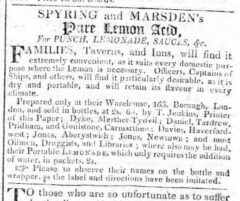
The solution mentioned here of using citric acid instead of fresh or preserved citrus juice, as it does not spoil, is also evident in the advertisements of the time. In 1811 it was advertised as: “FAMILIES, Taverns, and Inn, will find it extremely convenient, as it suits every domestic purpose where the Lemon is necessary. Officers, Captains of Ships, and others, will find it particularly desirable, as it is dry and portable, and will remain its flavour in every climate.“ [38]
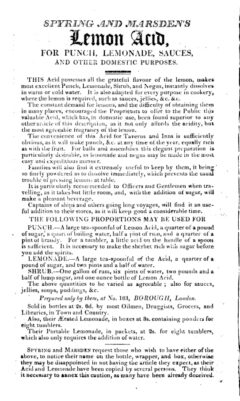
But back to the method described by Captain T. M. Bagnold of bottling lime juice and then preserving it by heating it in boiling water. This is a really important text. It shows that food was preserved by heating long before the invention of pasteurisation. The so-called pasteurisation developed by Louis Pasteur in 1864 is practically only a further development, because it is understood to mean the short-term heating to temperatures of at least 60 °C, which corresponds to Pasteuer’s classical method, or to a maximum of 100 °C, which is called high pasteurisation. Pasteurisation is still used today to gently preserve foods, including fruit juices. However, they are not germ-free, which is why they usually have to be stored in a cool place. For acidic foods with a pH value below 4.5, refrigeration is not necessary, as the acid also has a preserving effect. Only with sterilisation at higher temperatures are heat-resistant bacteria killed, so that sterilised foods can be kept unrefrigerated for a long time. [36]

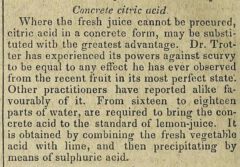
Preservation of lemon juice. Lemon-juice for the use of the navy, is often adulterated with vinegar, and sometimes contains the pulp, which renders it liable to ferment. Lemon and lime-juice, should therefore be procured in Portugal and the West Indies, and in each place be combined with calcareous earth. It may be imported in barrels, and in that state be sent to sea, when the separation of the liquid acid is so easy a process as to require no trouble, and the medicine will be always in the best state. Combined with calcareous earth, the acid will remain unchanged for a great length of time.” [28-292]
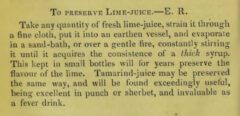
In 1840, Emma Roberts prepares a syrup: “TO PRESERVE LIME-JUICE. – E. R. Take any quantity of fresh lime-juice, strain it through a fine cloth, put it into an earthen vessel, and evaporate in a sand-bath, or over a gentle fire, constantly stirring it until it acquires the consistence of a thick syrup. This kept in small bottles will for years preserve the flavour of the lime.” [29-304]
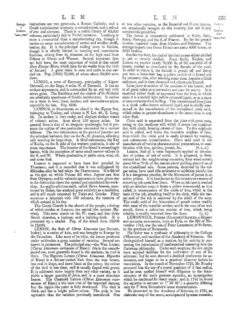
This eighth edition of the Encyclopaedia does not recognise the lime as an independent species, but mixes it with the lemon. However, it is found in later editions. The fourteenth, for example, understands “lime” to mean the linden tree, trees of the genus Tilia. [9-128] It refers to lemon: “For the sweet lime (Citrus Medicy var. Limetta) and lime-juice, see LEMON.” [9-129]

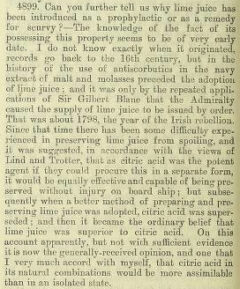

Salicylic acid was still relatively new. It was first isolated by Raffaele Piria in 1838. It was not until 1874 that the synthesis of salicylic acid was produced at the salicylic acid factory Dr. F. von Heyden in Dresden. [35]


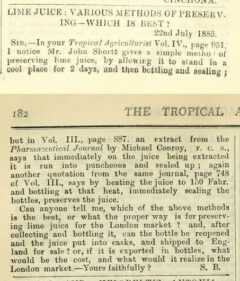
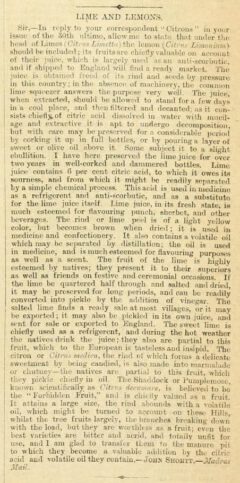
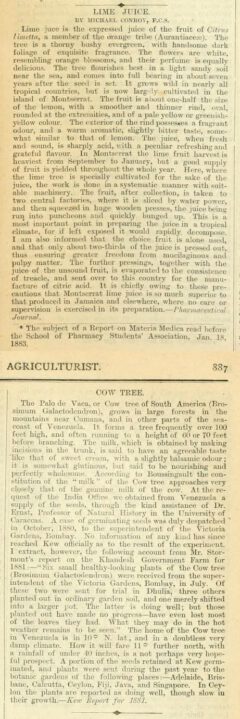
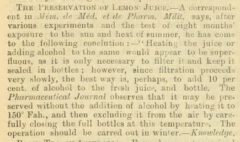
The third text is also included in the second volume: “THE PRESERVATION OF LEMON JUICE. — A correspondent in Mém. de méd. et de Pharm. Milit. says, after various experiments and the test of eight months’ exposure to the sun and heat of summer, he has come to the following conclution : — “Heating the juice or adding alcohol to the same would appear to be superfluous, as it is only necessary to filter it and keep it sealed in bottles; however, since filtration proceeds very slowly, the best way is, perhaps, to add 10 per cent. of alcohol to the fresh juice, and bottle. The Pharmaceutical Journal observes that it may be preserved without the addition of alcohol by heating it to 150° Fah., and then excluding it from the air by carefully closing the full bottles at this temperature. The operation should be carred out in winter.” [24-748]

Unfortunately, we did not find an answer to the question posed in the letter to the editor. However, there are other interesting reports in the Tropical Agriculturist, for example in the sixth volume: “Limes, I know, are cultivated in Trinidad, and the export of crude lime-juice may have been already attempted. The most acceptable form however for presenting lime-juice in the market is as “Concentrated Juice.” This is prepared by boiling the crude juice down to the consistency of thick molasses. The proportion of concentrated juice to the raw juice should be as 1 to 16. Just at present concentrated lime-juice is selling at very high rates, viz : — about £30 per pipe.” [25-230]

Another account reads: “The lime is cultivated in the West Indies for the production of lime-juice, in which there is a large and paying trade to Europe, after the juice has been boiled down to a certain state of condensation.” [25-418]
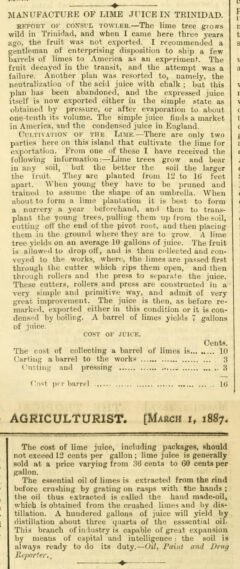
Here are a few more recipes for preserving lime juice:





This reference shows us that even around 1890 the lime juice served must have been of rather dubious taste, otherwise the palatability would not have been explicitly pointed out.

In 1901, the benefits of preservatives are pointed out: “To Preserve Lime-juice, salicylic acid, in the proportion of 60 to 80 gr. per gal. suffices.” [34-67]

In 1905 is written about preservation: “The “Journal of the Jamaica Agricultural Society” gives the following as the methods adopted for the preservation of lime or lemon juice: The juice as it is squeezed out from the fruit is allowed to rest for twenty-four hours until a sediment collects at the bottom of the vessel. Then the clear liquid is decanted and reduced by heat to one-third of its volume — i.e., 3 quarts of juice would be reduced to 1 quart. The heating process should not be done by direct fire, but by standing the vessel containing juice into a copper or some large vessel over the fire. On a large scale a water-bath or steam circulating in a jacket boiler could be used. In any case, the vessel in which the juice is heated should be enamelled. The juice may be sweetened by adding 4 to 5 lbs. of sugar for every gallon of juice before it is reduced by heat. It is bottled when cool, but before bottling it may require straining or filtering. To prevent deterioration by mould the bottles, which are filled to an inch from the cork (which is tied down), are placed standing in a flat-bottomed boiler. Water is placed in the boiler up to an inch from the neck of the bottles, and then heated by direct fire up to 170° F., and kept at that temperature for about twenty-five minutes. Then they are removed and laid on one side, never standing. To prevent heating of the bottles it would be well to have a false perforated bottom of wooden battens placed in the boilers. The method of preserving lemon-juice, as used in the navies, is to add 10 per cent. of brandy — that is, 1 gal. of brandy to 9 gals, of juice — after it has been treated.” [21-855]
Summary
If we summarise the various preservation methods after this extensive collection of quotations, the following possibilities emerge:
- Heating and addition of alcohol
- Addition of alcohol
- Heating
- Addition of sugar and heating
- Addition of lime
- Boiling down (turning into a syrup)
- Addition of salicylic acid
- Addition of nitric acid, sulphuric acid or hydrochloric acid
- Addition of sugar
- Boiling down with the addition of sugar
In the next part, we will take a closer look at Rose’s Lime Juice. When was it created? Is it still produced today as it was shortly after the patent was granted in 1868?
Sources
- https://archive.org/details/letterstoftg170304madr/page/108/mode/2up?q=%22lime+juice%22 Anonymus: Letters to Fort St. George 1703-1704. Volume IX. Madras, 1931.
- https://de.wikipedia.org/wiki/Fort_St._George Fort St. George.
- https://archive.org/details/britishempireina04oldm/page/154/mode/2up?q=%22lime+juice%22 Anonymus (John Oldmixon): The British empire in America, containing the history of the discovery, settlement, progress and present state of all the British colonies, on the continent and islands of America. The second volume. Being an account of the country, soil, climate, product and trade of Barbados, St. Lucia, St. Vincents, Dominico, Antego, Montserrat, Nevis, St. Christophers, Barbuda, Anguilla, Jamaica, the Bahama and Bermudas Islands. With curious maps of the several places done from the newest surveys. London, 1708.
- https://archive.org/details/vectigaliumsyste00edga/page/58/mode/2up?q=%22lime+juice%22 William Edgar: Vectigalium systema: or, A complete view of that part of the revenue of Great Britain, commonly called customs. … London, 1714.
- https://archive.org/details/b30515750/page/28/mode/2up?q=%22lime+juice%22 George Smith: A Compleat Body of Distilling, Explaining the Mysteries of that Science, in A most easy and familiar Manner; Containing an Exact and accurate Method of making all the Compound Cordial-Waters now in Use, with A particular Account of their several Virtues: As also a Directory Consisting of All the Instructions necessary for learning the Distillers Art; with a Computation of the original Cost of the several Ingredients, and the Profits arising in Sale. Adapted no less to the Use of private Families, than of Apothecaries and Distillers. In two Parts. London, 1725.
- https://archive.org/details/101091222.nlm.nih.gov/page/n197/mode/2up?q=%22lime+juice%22 Anonymus: The complete family-piece: and, country gentleman, and farmer’s best guide: in three parts … London, 1736
- https://archive.org/details/dasbritischereic00oldm_0/page/n203/mode/2up?q=%22lime+juice%22 Anonymus (John Oldmixon): Das Britische Reich in America Worinnen enthalten Die geschichte der Entdeckung, der Aufrichtung, des Anwachses und Zustandes der Englischen Colonien Auf dem festen Lande und den Inseln von America. Der zweyte Theil Welcher in sich begreifft Eine Beschreibung des Landes, des Erdbodens, der Himmels-Lust, er Früchte und Handlungen von Barbados, St. Lucia, St. Vincemts, Dominico, Antego, Montserrat, Nevis, St. Christophers, Barbuda, Anguila, Jamaica, Bahama und Bermudas. Nebst Fortsetzung dieser Geschicht und der Veränderung des Staats und der Handlung solcher Colonien, von dem Jahre 1710. bis auf gegenwärtige Zeit. Wo bey Gelegenheit auch einige Anmerkungen, welche die möglichsten und nützlichsten Mittel anzeigen, wie man diese Pflanz-Städte in einen blühenden Zustand setzen, und für ihre Sicherheit Sorge tragen sol, beygefüget werden. Mit Land-Charten des berühmten Hn. Molls versehen, und nach der neuesten Herausgebung von 1741. aus dem Englischen ins Teutsche übersetzet von Theodor Arnold. Lemgo, 1744.
- https://archive.org/details/in.ernet.dli.2015.209722/page/n339/mode/2up Anonymus: The Encyclopaedia Britannica, or Dictionary of Arts, Sciences, and general Literature. Eigth Edition. Volume XIII. Edinburgh, 1857.
- https://archive.org/details/in.ernet.dli.2015.211452/page/n165/mode/2up Anonymus: The Encyclopaedia Britannica, or Dictionary of Arts, Sciences, and general Literature. Fourteenth Edition. Volume XIII. London, 1932.
- https://archive.org/details/in.ernet.dli.2015.211462/page/n767/mode/2up?q=%22lime+juice%22 The Encyclopaedia Britannica. Fourteenth edition, Volume 3. 1932.
- https://archive.org/details/philadelphiamedi3180coxe/page/n377/mode/2up?q=%22lime+juice%22 John Redman Coxe: Philadelphia Medical Museum. Philadelphia, 1807.
- https://archive.org/details/in.ernet.dli.2015.83799/page/n207/mode/2up?q=%22preserving+lime-juice%22 Lawrence Dundas Campbell: The Asiatic Register. Vol. VIIII, for the year 1805, Part 1. London, 1809.
- https://archive.org/details/transactionssoc00artsgoog/page/n136/mode/2up?q=%22preserving+lime-juice%22 Anonymus: Transactions of the Society Instituted at London for the Encouragement of Arts, Manufacture and Commerce; With the Premiums Offered in the Year 1824. London, 1825.
- https://archive.org/details/selectionsfromc00kargoog/page/n198/mode/2up?q=%22preserving+lime-juice%22 W. S. Seton-Karr (Hrsg.): Selections from Calcutta Gazettes of the years 1798, 1799, 1800, 1801, 1802, 1803, 1804, and 1805, showing the political and social condition of the English in India. Calcutta, 1868.
- https://archive.org/details/outlinesofnavalh00macd/page/236/mode/2up?q=%22preserving+lime-juice%22 John Denis Macdonald: Outlines of naval hygiene. London, 1881.
- https://archive.org/details/b24397945/page/158/mode/2up?q=%22preserving+lime-juice%22 Anonymus: Report of the Commitee appointed by the Lords Commissioners of the Admiralty, to enquire into the causes of the outbreak of scurvy in the recent Arctic Expedition; the adequacy of the provision made by the Admiralty in the way of food, medicine, and medical comforts; and the propriety of the orders given by the commander o[f] the Expedition for provisioning the sledge parties. London, 1877.
- https://archive.org/details/canadamedicalrec04montuoft/page/234/mode/2up?q=%22preserving+lime-juice%22 Francis Wayland Campbell (Hrsg.): The Canada Medical Record; A Monthly Journal of Medicine and Surgery. May 1878.
- https://archive.org/details/dli.granth.44886/page/294/mode/2up?q=%22preserving+lime-juice%22 The Hindoo Patriot, 23. June 1884.
- https://archive.org/details/b19974760M0339/page/480/mode/2up?q=%22preserving+lime-juice%22 Anonymus: The Chemist and Druggist. 15. August 1885.
- https://archive.org/details/dp0010595/page/n1/mode/2up?q=%22preserving+lime-juice%22 Lochmede vol. 2, no. 40, 5. October 1888, page 2.
- https://archive.org/details/b19974760M1415/page/854/mode/2up?q=%22preserving+lime-juice%22 Anonymus: The Chemist and Druggist. 25. November 1905.
- https://archive.org/details/tropicalagricult18851886colo/page/180/mode/2up?q=%22preserving+lime-juice%22 A. M. & J. Fergusin (editor): The Tropical Agriculturist. Vol. 5. 1885-1886. Colombo, Ceylon.
- https://archive.org/details/tropicalagricult18841885colo/page/950/mode/2up A. M. & J. Fergusin (editor): The Tropical Agriculturist. Vol. 4. 1884-1885. Colombo, Ceylon.
- https://archive.org/details/tropicalagricult18821883colo/page/n905/mode/2up A. M. & J. Fergusin (editor): The Tropical Agriculturist. Vol. 2. 1882-1883. Colombo, Ceylon.
- https://archive.org/details/tropicalagricult18861887colo/page/230/mode/2up?q=%22lime+juice%22 A. M. & J. Fergusin (editor): The Tropical Agriculturist. Vol. 6. 1886-1887. Colombo, Ceylon. 1885
- https://archive.org/details/in.ernet.dli.2015.38540/page/n467/mode/2up?q=%22lime+juice%22 Anonymus: The housekeeper’s magazine, and family economist. London, 1826.
- https://archive.org/details/historyofmedicin0000lang/page/70/mode/2up?q=%22preserving+lime-juice%22 Harold D. Langley: A history of medicine in the early U.S. Navy. 1995.
- https://archive.org/details/fivethousandrece00mack/page/292/mode/2up?q=%22lime+juice%22 Colin Mackenzie: Five thousand receipts in all the useful and domestic arts, constituting a complete and universal practical library, and operative cyclopædia. Philadelphia, 1829.
- https://archive.org/details/b21531122/page/304/mode/2up?q=%22preserve+lime-juice%22 Emma Roberts: A new system of domestic cookery. London, 1840.
- https://archive.org/details/punchv51lemo/page/248/mode/2up?q=%22preserve+lime-juice%22 Punch, or The London Charivari. 15. December 1866.
- https://archive.org/details/unrivalledcookbo00wash/page/494/mode/2up?q=%22preserve+lime-juice%22 Mrs. Washington: The unrivalled cook-book and housekeeper’s guide. New York, 1886.
- https://archive.org/details/b21528378/page/208/mode/2up?q=%22preserve+lime-juice%22 W. H. Dave: The wife’s help to Indian cookery: being a practical manual for housekeepers. London, 1888.
- https://archive.org/details/b20411273/page/252/mode/2up?q=%22preserve+lime-juice%22 William E. Riordan: Manual for army medical services. London, 1890.
- https://archive.org/details/b19974760M1152/page/66/mode/2up?q=%22preserve+lime-juice%22 The Chemist and Druggist. 12. January 1901.
- https://de.wikipedia.org/wiki/Salicyls%C3%A4ure Salicylsäure.
- https://de.wikipedia.org/wiki/Pasteurisierung Pasteurisierung.
- https://books.google.de/books?id=TOERAAAAYAAJ&pg=PT29&lpg=PT29&dq=%22aerated+lemonade%22&source=bl&ots=wtjRDdGIKV&sig=ACfU3U1WRHMex6tMQYmqTNV2LxEx92UQHQ&hl=de&sa=X&ved=2ahUKEwi6vajw94fnAhXtN-wKHUGfBckQ6AEwDHoECAcQAQ#v=onepage&q=%22aerated%20lemonade%22&f=false The repository of arts, literature, commerce, manufactures, fashions and politics. Vol. 11. 1. May 1814
- https://newspapers.library.wales/view/3322540/3322544/16/ The Cambrian. 10. August 1811, page 4.
- David Wondrich: Punch. The Delights (and Dangers) of the Flwing Bowl. An Anecdotal History of the Original Monarch of Mixed Drinks, with More Than Forty Historic Recipes, Fully Annotated, and a Complete Course in the Lost Art of Compounding Punch. ISBN 978-0-399-53616-8. New York, Pedigree Book, 2010.
- https://archive.org/details/surgionsmateortr00wood/page/184/mode/2up?q=scurvy Iohn Woodall: The Svrgions Mate, or a treatise discouering faithfully and plainely the due contents of the Svrgions chest, the vses of the instruments, the vertues and operations of the medicines, the cures of the most frequent diseases at sea: namely wounds, apostumes, vlcers, fistulaes, fractures, dislocations, with the true maner of amputation, the cure of scuruie, the fluxes of the belly, of the collica and the illiaca paßio, tenasmus, and exitus ani, the callenture; with a briefe explanation of sal, sulphur, and mercury; with certaine characters, and tearmes of arte. Published chiefly for the benefit of young sea-surgions, imployed in the East-India Companies affaires. London, 1617.
- https://de.wikipedia.org/wiki/Vitriole Vitriole.
- https://en.wiktionary.org/wiki/spirit_of_vitriol Spirit of vitriol.
- https://en.wikipedia.org/wiki/Vitriol Vitriol.
- https://en.wikipedia.org/wiki/Sulfuric_acid Sulfuric acid.
- https://de.wikipedia.org/wiki/Schwefels%C3%A4ure Schwefelsäure.
- https://de.wikipedia.org/wiki/Kalkstein Kalkstein.
- https://archive.org/details/paper-doi-10_1098_rstl_1753_0025 Experiments by Francis Hume, M. D. on Fish and Flesh Preserved in Lime-Water, Communicated by John Clephane, M. D. F. R. S.
- https://archive.org/details/philtrans07937869/mode/2up An Account of Some Trials to Keep Water and Fish Sweet, with Lime-Water. By Stephen Hales, D. D. F. R. S.
- https://archive.org/details/b31885317/page/n1/mode/2up Thomas Henry: An account of a method of preserving water, at sea from putrefaction, and of restoring to the water its original pleasantness and purity, by a cheap and easy process; to which is added a mode of impregnating water, in large quantities, with fixed air, for meicinal uses, on board ships, and hospitals; and likewise a process for the preparation of artificial yeast. London, 1781.
- https://de.wikipedia.org/wiki/Thomas_Henry_(Apotheker) Thomas Henry (Apotheker).
- https://de.wikipedia.org/wiki/Kohlens%C3%A4ure Kohlensäure.
- https://de.wikipedia.org/wiki/Calciumoxid Calciumoxid.
- https://en.wikipedia.org/wiki/Calcium_oxide Calcium oxide.
- https://navymedicine.navylive.dodlive.mil/archives/13070 The navy’s fight against scurvy. Von André B. Sobocinski.
- https://archive.org/details/sim_newcastle-general-magazine_1747-10/page/268/mode/2up?q=%22a+mixture+of+lemon+juice%22 The General Magazine, For October, 1747.
- https://archive.org/details/in.ernet.dli.2015.271834/page/n789/mode/2up Anonymus: The Oxford Dictionary. Vol. IX. S-Soldo. 1933, reprinted 1978.
- https://www.diffordsguide.com/encyclopedia/535/bws/shrubs Tim Oakley: Shrubs. 9. August 2011.
- https://books.google.de/books?id=4KOAg0mBzeEC&pg=PP3&lpg=PP3&dq=pastry+cook%27s+vade-mecum+1705&source=bl&ots=gF3DG8mPC4&sig=ACfU3U3IGUTBnlNy5PXjKo2jIUxl4YZUpQ&hl=de&sa=X&ved=2ahUKEwiMpree08v6AhU6W_EDHRvSB084FBDoAXoECBgQAw#v=onepage&q=shrub&f=false Anonymus: The Pastry-Cook’s Vade-Mecum: or, a pocket-companion for cooks, house-keepers, country gentlewomen, &c. London, 1705.
- https://archive.org/details/b21533908/page/n325/mode/2up?q=punch Anonymus: Apicius redivivus; or The cook’s oracle: wherein especially the art of composing soups, sauces, and flavouring essences is made so clear and easy, by the quantity of each article being accurately stated by weight and measure, that every one may soon learn to dress a dinner, as well as the most experienced cook; being six hundred receipts, the result of actual experiments instituted in the kitchen of a physician, for the purpose of composing a culinary code for the rational epicure, and augmenting the alimentary enjoyments of private families; combining economy with elegance; and saving expense to housekeepers, and trouble to servants. London, 1817.
- https://archive.org/details/historyofnewswed00acre/page/162/mode/2up/search/punch Israel Acrelius: A history of New Sweden; or, the settlements on the river Delaware. Philadelphia, 1874.
- https://en.wikipedia.org/wiki/Israel_Acrelius Israel Acrelius.
explicit capitulum
*

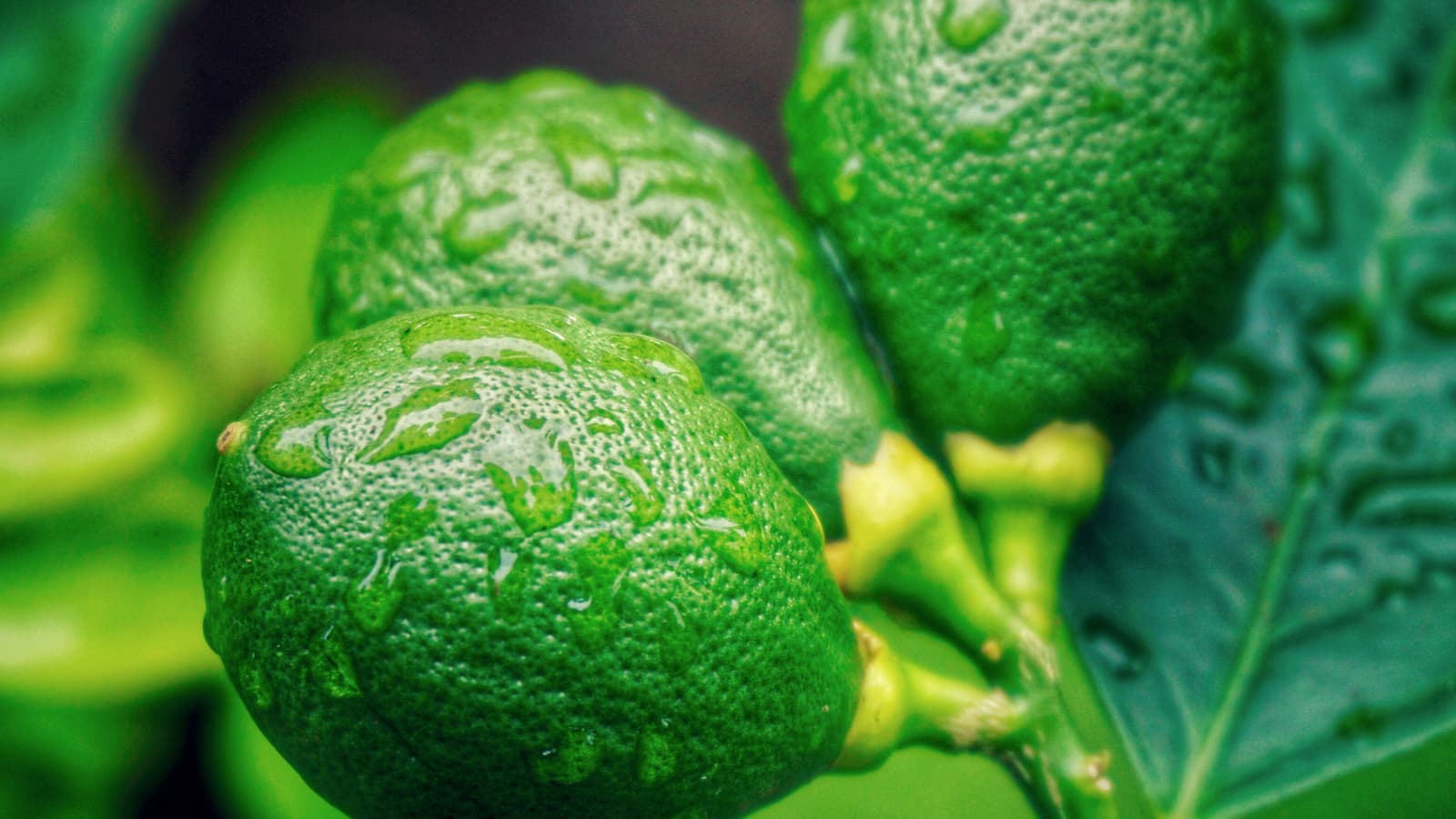
Hi there, the ‘slack’d lime’ meantioned here that makes lime-water refers to slaked lime – this is another name for the compound- calcium hydroxide, rather than lime (the fruit). Otherwise, what an interesting article! Thanks for the great information.